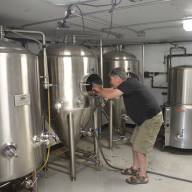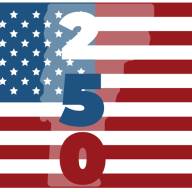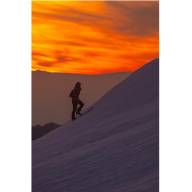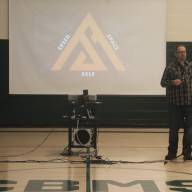I think empathy is something we need to understand further,” Janet Dandridge, an artist and resident of Warren, told the Warren Planning Commission at its April 22 meeting. She was asking commissioners for support in developing an interactive public artwork in the town.
Her idea is to create a series of large circles on the ground – using thermoplastic paint or other materials – that offer prompts to either give or receive a compliment to those standing in other circles, or those passing by. She calls the installation a “compliment sandwich,” and said the idea was inspired by children’s games.
“What I’ve been striving to do is to create moments of conversation, peace and love,” she said. “I think that’s absolutely needed. And if we can actually drop [the circles] into spaces where people are walking, or hiking, or relaxing, I think it could create a moment of synergy between humans where we can build relationships.”
SIDEWALK CHALK
Dandridge has primarily worked with mediums of performance art, photography, and other media. Her first iteration of “compliment sandwich” was done with sidewalk chalk in the Lower East Side Manhattan, New York City, in the summer of 2019. She developed the idea as part of a cohort for the New York University (NYU) Hemispheric Institute of Performance and Politics – a program founded two decades ago that brings together artists, scholars, and activists to collaborate on artworks that center on social justice.
She grew up in Washington, DC, in a creative household where her mother made art and her family frequented museums. She studied film and television production for her undergraduate degree in New York, then went on to earn a Master of Fine Arts in Los Angeles. Early on, she was drawn to the intersection of art and activism, or “artivism” – a term coined in the late 1990s by Chicano artists in the U.S. and the Zapatistas in Mexico. She saw the potential for public art to challenge injustices and fight oppression – increasing civic engagement and even catalyzing changes in public policy.
THE FOREST
Currently, Dandridge is a working artist and educator at George Mason University School of Art, teaching online classes from her Warren residence. She moved to Warren three years ago to raise her now 2-year old son, “who paints on everything,” she said.
“I’m embracing living in the forest,” she said, laughing, “but it’s been an extreme challenge to live in this place.” She described grappling with health care access issues and having limited choices of where to send her son to school, and the lack of racial and cultural diversity. Dandridge said she’s experienced racism in Vermont and thinks a lot about how her son will experience it too.
The ability to understand and invest oneself in the feelings and experiences of another person, then, is important in Dandridge’s work. She advocates for spaces and processes in which “people can become more open to dialogue and kinship.”
A CHALLENGE
“Trying to communicate with people here is a challenge,” she added. Still, she hopes to keep forging connections in order to materialize her artwork – planning to use the Warren Public Library’s 3D printer to create a mock-up of her project, and connect with high school students who are interested in learning about the process of bringing public artworks to life.
Dandridge presented a few examples of public artworks to the planning commission at its meeting, including the Barre Art Stroll – a printable map and self-guided tour of artworks in the downtown area, and Cold Hollow Sculpture Park – 70 large sculptures that blanket 200 acres of fields and forest in Enosburg. Her idea, however, is a bit different in that it’s participatory – not intended for passive viewing.
Planning commissioners said they liked her idea and ultimately pointed her to inquire with the Warren Select Board. Commissioner Dan Raddock said he understood the need for increased social connection – that in the aftermath of a pandemic, inundated by technologies, “we’re really very isolated, and somewhat hostile to each other in a way that I don’t remember [from before the pandemic].”
PUBLIC WORKS
“Something’s been lost in recent years that would be great to reclaim,” he said.
Mad River Valley Arts (MRVA) director Sam Talbot-Kelly said that towns – particularly their chambers of commerce – should be working to support the arts. “The arts are important as the roads, and equal to any infrastructure,” she said. “It keeps a community alive, and healthy, and vibrant. And it gives people things to do.”
Planning and developing public artworks can come with challenges, she said – as grants are competitive, towns may see public works as a liability, and getting approval to use public or privately-owned land can be tricky. Talbot-Kelly and Dandridge both agreed that convincing municipalities and the public that the arts have value can also be tough. “It’s just not a given,” Talbot-Kelly said.
But without a community’s investment in the arts, Talbot-Kelly added, “the social fabric would disintegrate.”













